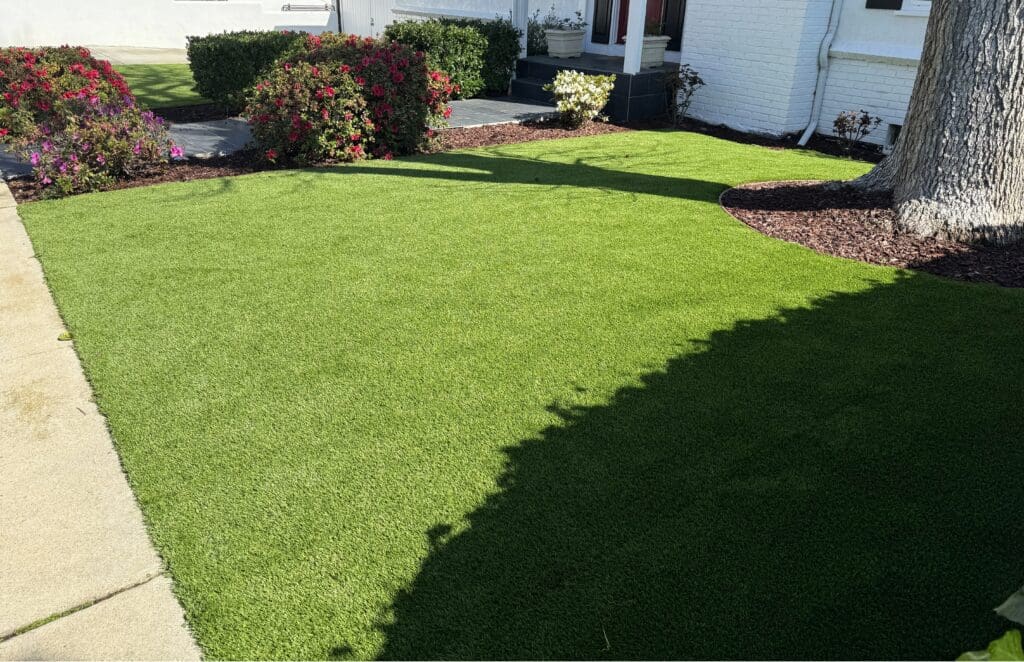
Fake grass contains polyethlene that breaks down, leaving PFAS (forever chemicals) that are known carcinogens. Fake grass also traps heat and remains hotter than plants.
Scientists were analyzing coastal waters of Spain when they made a discovery: polyethlene in the water from artificial turf.
Fake turf is made from polyethylene, which can last from 10 to 20 years. As the artificial grass breaks down, small pieces of plastic can make their way into soil and waterways.
Scientists said, “We were really surprised that nobody had reported this before.”
In Jeanette Marantos’ “swan song” story for the L.A. Time Plants Column (she was among the 115 layoffs in January), she wrote “I’d like to discuss an important topic that causes much teeth-gnashing and despair among advocates for the natural world — the dreaded plastic carpet ‘lawn’ known as artificial turf.”
In Marantos’ column, she quoted California Wild Gardens’ Briana Lyon, “It’s extremely toxic to the environment, it sheds micro plastics nonstop and it’s single-use plastic that usually ends up in a landfill because it doesn’t compose.
“It breeds bacteria from animal waste, it’s as hot as concrete. . .and it destroys the soil underneath,” Lyon said. “It takes months to repair the soil when you remove it, I would rather see people plant traditional water-guzzling turf rather than artificial turf.”
Marantos reported that “Back in 1981 William B. Davis, a UC Davis environmental horticulturalist, did a study comparing the temperature of bluegrass cut to varying heights and artificial turf on a 78-degree day in October. Interestingly, the bluegrass turf got cooler as it got longer — about 67 degrees at 6 inches of height to 83 degrees at a half inch of height. But the artificial turf clocked in at 125 degrees, 46 degrees above the air temperature.”
In a Cal Matters October 2023 story (“Once It Was Hailed as a Drought Fix-But Now California’s Moving to Restrict Synthetic Turf over Health Concerns”), Kelly Turner, associate director of the UCLA Luskin Center for innovation’s Heat Equity Initiative, said the material can trap heat and radiate it back slowly, staying warm for longer periods of time.
“It is one of the hottest surface materials,” she said. “It is hotter than asphalt.”
Artificial turf also releases greenhouse gases. Polyethlene, used for making grass blades, emits greenhouse gases, ethylene, propylene and methane into the atmosphere as it breaks down. Methane is 20 times more powerful at warming the atmosphere than carbon dioxide.
“I keep seeing more and more installations of fake grass in my immediate neighborhood, as though it’s a knee-jerk response: rip up your lawn and put down plastic. And each new installation raises my blood level,” said Carol Bornstein, a horticulturist and author. “A lot of people don’t understand natural processes and how important they are to our well-being; not just other creatures, but our well-being. Landscapes are not static things; they are dynamic. They are supposed to grow.”
Fake grass contains PFAS, a known carcinogen, which can enter the body through contact with skin, by breathing the particles or through water sources.
PFAS have been called “forever chemicals”, because they can last thousands of years. Every American tested has PFAS in their blood, which is a problem because even small doses of the chemical can cause kidney and testicular cancer, liver problems, high cholesterol, and immunosuppression.
Marantos writes. “This is all part of our world, and if we keep smothering the soil and all the goodness it can grow, it’s going to go away — and maybe poison us in the process as it departs.”
In October, Governor Gavin Newsom signed a law that allows California Cities to ban synthetic turf but rejected a bill to ban PFAS in fake lawns, because the bill didn’t identify a regulatory agency to ensure compliance.
CTN received a note from a reader who urged residents to try something other than fake grass and to stop worrying if a lawn is not perfect.
“I want to encourage people to aspire for something other than the monoculture look. In my lawn, I’ve seeded blank spots with lawn daisies, (Bellis perennis) and I’m now treated to non-stop flowers and butterflies and birds. We are so lucky that we can have flowers 12 months of the year!”


Thank you for the ‘artificial turf’ summary. Somehow, people – including some “landscapers”! – still don’t get the dreadful picture.
My problem came from beneath the turf. Don’t know if it’s moles…or another type of rodent. I know planted new lawns twice, hoping for a miracle. ‘Even my gardener gave up. This was a 45 year battle.
Our front yard we filled with stones but couldn’t do that in back, our dog would have revolted and it is a large area in the middle of our view as you step out of the back door. That’s my excuse and I’m stuck with it
Sylvia Boyd